Early-Onset Gingivitis (EOG)/Aggressive Periodontitis (AP)
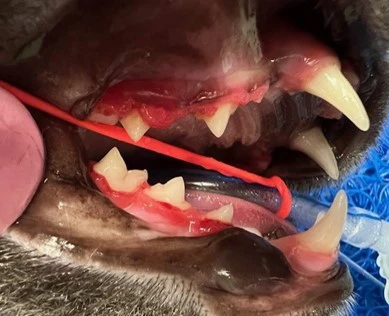
Visual assessment showing generalised gingival inflammation. Note the inflammation does not extend beyond the muco-gingival junction.
Early-Onset Gingivitis (EOG) describes inflammation of the gingival tissues of permanent teeth in young cats (usually 6-8 months of age). The affected cats present with marked gingival inflammation, erythema, oedema and bleeding.
Aggressive Periodontitis (AP) is seen by extension of this inflammation into deeper structures, leading to attachment loss, periodontal pocketing, gingival recession and early tooth loss. This can be seen with or without gingival enlargement. AP is estimated to occur in up to 13% of young adult cats.
This disease is characterised by rapid progression of periodontitis, with an earlier age of onset and progression than (chronic) periodontitis. Historically, the term feline juvenile gingivitis has been used. The EOG/AP lesions is noted as moderate to severe gingivitis that do not cross the mucogingival junction.
Diagnosis is made based on history, clinical findings, dental radiography (for assessing attachment loss, missing teeth and other pathology) and is confirmed by histopathologic evaluation (moderate to severe, erosive to ulcerative, neutrophilic and lymphoplasmacytic inflammation). Moderate to severe periodontitis and missing teeth are predominant features.
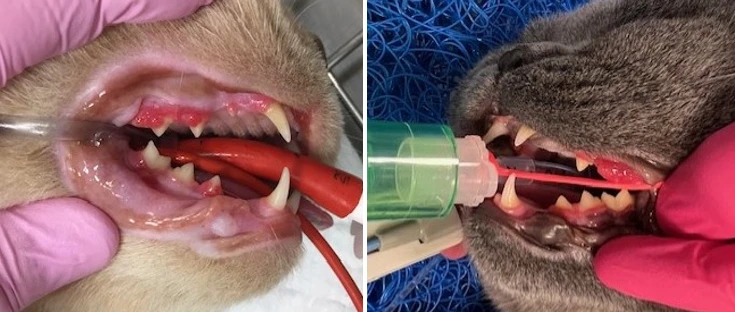
Note gingival enlargement associated with the maxillary premolars in 2 cases of EOG.
EOG/AP may also progress to feline chronic gingivostomatitis (FCGS). EOG/AP is an indication for professional periodontal care and long-term follow up due to the potential of this disease progressing to FCGS. Treatment consists of
- periodontal treatment: sub and supragingival scaling, selective teeth extractions +/- full mouth extractions.
- NSAIDs, analgesia and topical antimicrobial therapy extending between 3 days and 2 weeks post surgery.
The lack of improvement of clinical signs and evidence of gingivitis at the healing recheck is associated with disease progression.
Feline Chronic Gingivitis Stomatitis (FCGS)
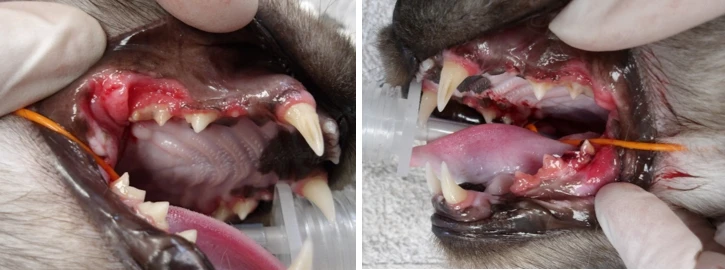
Case of FCGS – note distribution of inflammatory lesions affecting the gingiva and mucosa
FCGS has a reported prevalence of between 0.7% and 12% of cat dental cases seen in practice. Since inflammation in the oral cavity may be caused by multiple dental diseases (eg Periodontal disease, tooth resorption), a diagnosis of FCGS is based on the distribution of presenting lesions and ruling out other disease processes during the full oral assessment and dental radiography. The diagnosis may be supported by histopathology.
Multiple factors may be involved in a cat presenting with FCGS and includes the presence of dental diseases, environmental stressors, and hypersensitivity. Infectious agents such as feline calicivirus (FCV), feline herpesvirus (FHV-1), feline immunodeficiency virus (FIV), feline leukemia virus (FeLV), and presence of various bacteria have been implicated, however no causative agents have been proven.
Although the exact etiopathogenesis of FCGS remains unclear, it seems to be an expression of an inappropriate immune response to antigenic stimulation from oral plaque biofilm, which may be potentiated or exacerbated by viral infection.
Cats with FCGS have generalized periodontitis (at varying stages) and they are also significantly more likely to have Tooth Resorption (TR). This demonstrates the importance of dental radiography in the evaluation and diagnosis of cats with FCGS. The Stomatitis Disease Activity Index (SDAI) is an invaluable tool for aiding diagnosis and assessing response to treatment.
In general, there are two approaches to the treatment of FCGS: surgical and medical. Medical treatment, on its own typically does not have favourable long-term outcomes. The current standard of care is dental extractions with or without additional long term medical management.
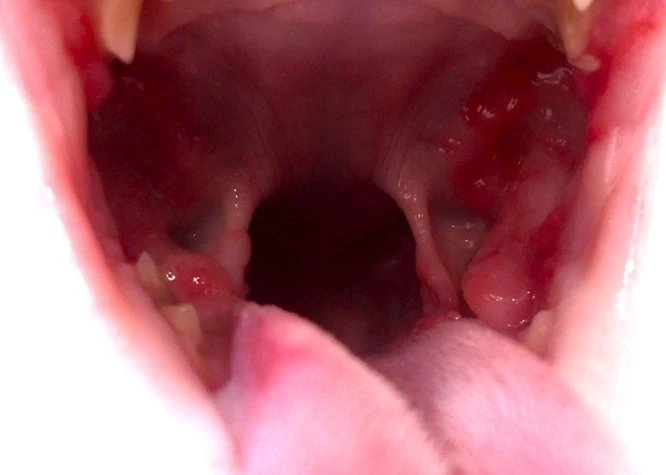
Note oropharyngeal inflammation
Surgical Treatment
A few studies have shown that partial (all premolar and molar teeth) or full-mouth extraction provides the best long-term results. These studies report substantial improvement or resolution of FCGS in approximately 70% to 80% of cats, with approximately 20% to 30% of cats showing minimal or no improvement (Jennings et al, 2015).
The extent of dental extractions seems to have no impact on outcome. Therefore, partial-mouth extraction (including any other teeth that have indications for extraction, eg: severe periodontitis, retained tooth roots, or resorptive lesions) as the initial stage of treatment is recommended. If there is no positive response within 1 to 4 months after partial-mouth extraction, full-mouth extractions may be considered as the second stage of treatment.
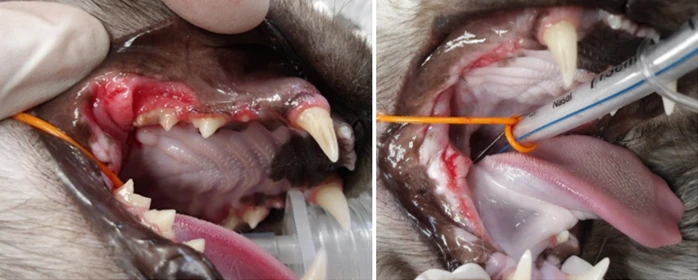
Comparison of the mouth immediately before and 4 weeks post-extractions of cheek teeth
Medical Management
Most cats with FCGS require medical management in addition to surgical treatment, and some may depend on life-long medication. Because FCGS is an immune-mediated inflammatory disease, analgesia together with immunosuppressive or immunomodulatory medications underpin the basis for medical therapy.
Regardless of treatment modality, all treatment options require adequate pain management. Appropriate analgesics used will depend on co-morbidities (eg, renal or hepatic disease), concurrent medications (eg, corticosteroids) and compliance in administering medications. Long-term analgesia includes non-steroidal anti-inflamatories (NSAIDs), opioids (eg, trans-mucosal buprenorphine) and gabapentin / amantadine as the most common options.
Evidence of esophagitis was found via esophagoscopy in 98% of cats with FCGS, compared with control cats in a study. Diagnosis and treatment or empiric treatment of esophagitis may be considered in cats affected by FCGS. (Kouki, 2017).

QR code for ISFM Article 2023